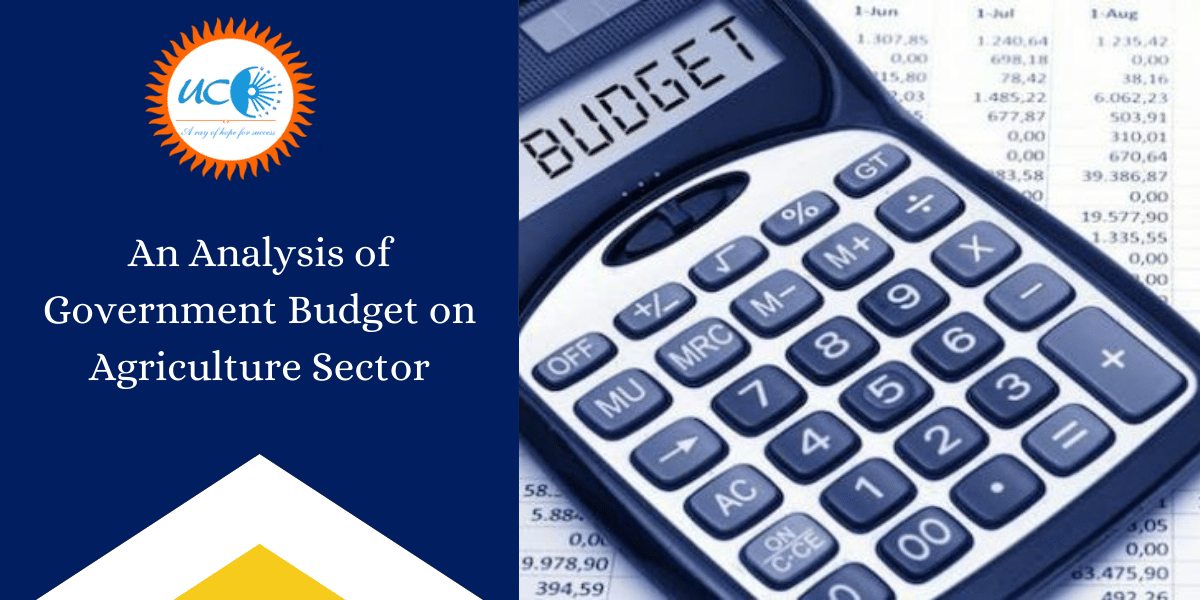An Analysis of Government Budget on Agriculture Sector
On February 1st 2021, Our Finance Minister Nirmala Sitaraman presented Union Budget 2021-22 in Parliament, which is the first budget of this new decade and also a digital one in the backdrop of unprecedented COVID-19 crisis. Laying a vision for Aatma Nirbhar Bharat, this is an expression of 130 crore Indians who have full confidence in their capabilities and skills. The budget for the agricultural sector for the financial year 2021-22 is 1 .23 lakh crore. 5% more than last year budget.
Agriculture Infrastructure Development Cess would be levied on petrol, diesel, gold and other imports, to improve facilities for production, conservation and processing of farm produce. APMCs have been allowed to tap into the Rs.1 lakh crore Agriculture Infrastructure Fund (AIF). The AIF was created last year, as part of the COVID-19 stimulus package to develop cold chain storage and other post-harvest management infrastructure. The outlays for the income support scheme, PM-KISAN and schemes to provide a remunerative price for farm produce, such as PM AASHA and the Price Support Scheme have been slashed.
The Agriculture Infrastructure Development Cess would help ensure the availability of more funds for the development of the crucial forward linkages to the agricultural sector. By allowing the APMCs to avail credit from AIF the government seems to be indicating its support for the APMC and MSP based public procurement system. The APMCs can avail cheaper loans to help increase the quality of infrastructure.
National Agriculture Market (eNAM) is a pan-India electronic trading portal which networks the existing APMC mandis to create a unified national market for agricultural commodities. 1000 More mandis to be included in next fy 21.
The Agricultural Budget has seen a continues to rise from the financial year 2016 And this year the agricultural sector received a total of 4.25% of the entire financial budget thus we can see a lot of importance is being given to agricultural sector and it is more than 5% compared to last year budget.
But cuts in the allocation to schemes such as PM AASHA (this scheme which ensured about MSP about 22 crops was fixed by the central government which provides minimum support price for the farmers) & Price support scheme. Even the reduced allocation For PM KISAN(Pradhan Mantri Kisan Sammann Nidhi is an initiative by the government of India in which all farmers will get up to ₹6,000 per year as minimum income support.) may fail to reach its target of 14 crores.
In fact, the recent growth performance of the sector has led the Finance Minister not to have any increase in cash transfers under the Pradhan Mantri Kisan Samman Nidhi Scheme (PM-KISAN) from the existing Rs.6,000 per year. Access to a recent survey only 9 crores have been benefited from this scheme while the registered farmers are more than 14crore. Excluding the West Bengal state, there is a lot of controversies going on in the state regarding the issue of pm Kisan yojana.
The allocation under MIS-PSS for 2021-22 (Rs 1,500 crore) fell 25 per cent from this year and was half of 2019-20. Similarly, allocation under PM-AASHA came down to a mere Rs 400 crore in Budget 2021-22 from Rs 1,500 crore in 2019-20.
The share of agriculture in the gross domestic product (GDP) has reached almost 20 per cent for the first time in the last 17 years, making it the sole bright spot in GDP performance during 2020-21, according to the Economic Survey 2020-2021.
The budget proposes the modernization of 5 fishing harbours. The proposed five major fishing harbours are Kochi, Chennai, Visakhapatnam, Paradip and Petuaghat. Similarly, inland fishing harbours and fish-landing centres along the banks of rivers and waterways would also be taken up going ahead. To promote seaweed cultivation, a Multipurpose Seaweed Park would be established in Tamil Nadu.
The Blue Revolution centrally sponsored schemes have witnessed increased budget allocations. The increased allocations for the fishery and marine-based sectors would help develop
the coastal areas as hubs of economic activity. This would help generate newer employment opportunities and also ensure the welfare of the coastal communities.
A 10% customs duty would be levied on cotton imports and the levy on raw silk and yarn has been increased from 10% to 15%. Indian textile mills imported 10 lakh to 12 lakh bales of cotton a year. The levy on raw cotton imports would increase domestic cotton prices and this could benefit the farmers.
The budget has given much importance to farmers for their MSP but there is a long protest going on by the farmers to give legal writings of continuation of MSP.
The budget mainly speaks of the introduction of e-mandis, growth of agricultural infrastructure cold storage for the benefit of farmers, Blue revolution And sea weeding park in Tamilnadu.
It called for a gradual shift in how agriculture was viewed, “from a rural livelihood sector to a modern business enterprise”.






